Capacitors are vital components in electronics, but not all capacitors are the same. In this article, we’ll dive into the differences between Ceramic VS Electrolytic Capacitor. Each type has unique characteristics, advantages, and ideal applications.
Ceramic capacitors are known for their stability and reliability, while electrolytic capacitors offer higher capacitance values. Understanding these differences helps you choose the right capacitor for your projects. Let’s explore what sets these two types apart!
What Are Ceramic Capacitors?
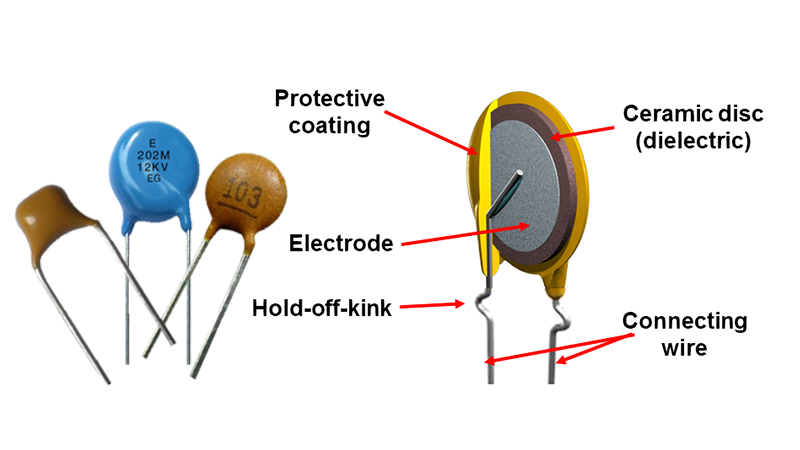
Ceramic capacitors, a staple in electronics, boast a construction centered around a ceramic material serving as the dielectric. This dielectric, sandwiched between two conductive plates, facilitates the storage and release of electrical energy.
Renowned for their diminutive stature, ceramic capacitors pack a powerful punch in terms of capacitance per unit volume. Their compact size makes them ideal for applications where space is at a premium, enabling efficient circuit designs in various electronic devices.
Beyond their size advantage, ceramic capacitors exhibit versatility in capacitance values, spanning from mere picofarads to several microfarads. This wide range accommodates diverse circuit requirements, from precision timing circuits to power supply decoupling.
Additionally, ceramic capacitors demonstrate admirable stability across different temperature ranges, ensuring reliable performance in varied environmental conditions. Their non-polarized nature simplifies circuit design and installation, allowing for hassle-free integration into electronic assemblies.
In essence, ceramic capacitors stand as indispensable components in modern electronics, delivering high performance, compactness, and reliability across a spectrum of applications.
Characteristics of Ceramic Capacitors
- Capacitance vs Voltage: Ceramic capacitors can have a wide range of capacitance values, typically from a few picofarads (pF) to several microfarads (µF). Their capacitance can vary with the applied voltage, which is something to consider in high-precision applications.
- ESR vs Frequency: Equivalent Series Resistance (ESR) of ceramic capacitors is generally low, which means they can operate efficiently at high frequencies. This makes them ideal for high-frequency applications such as RF circuits.
- Impedance vs Frequency: Ceramic capacitors have low impedance at high frequencies, which allows them to filter out high-frequency noise effectively.
Types of Ceramic Capacitors
- Multilayer Ceramic Capacitors (MLCC): These capacitors consist of multiple layers of ceramic dielectric and metal electrodes. They offer higher capacitance in a smaller package compared to single-layer ceramic capacitors.
- Ceramic Disc Capacitors: These are single-layer capacitors with a disc shape. They are typically used in lower capacitance applications.
- Monolithic Capacitors: These are similar to MLCCs but are made as a single piece without layers.
What Are Electrolytic Capacitors?
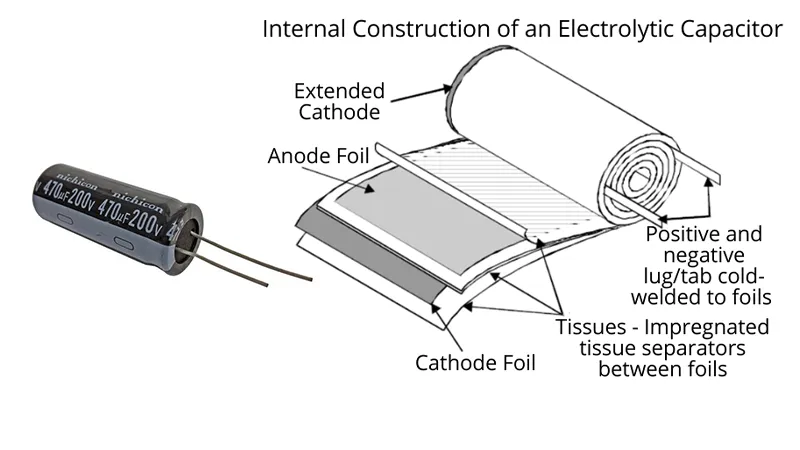
Electrolytic capacitors, in contrast to their ceramic counterparts, rely on an electrolyte as a key component to achieve heightened capacitance values. This electrolyte, typically housed within an aluminum or tantalum structure, facilitates the storage and discharge of electrical energy.
Notably, electrolytic capacitors exhibit polarization, necessitating correct orientation during installation to prevent catastrophic failure.
What distinguishes electrolytic capacitors is their impressive capacitance range, spanning from microfarads to thousands of microfarads. This expansive range renders them indispensable in applications demanding substantial energy storage, such as power supply filtering and bulk energy storage.
Furthermore, electrolytic capacitors excel in high-voltage applications, thanks to their robust construction and high dielectric strength.
While electrolytic capacitors offer significant advantages in terms of capacitance and voltage handling, they also come with considerations. Their polarization requires meticulous attention during installation, as reversing the polarity can lead to irreversible damage.
Electrolytic capacitors may exhibit limitations in high-frequency applications due to higher equivalent series resistance (ESR) and parasitic effects.
Characteristics of Electrolytic Capacitors
- High Capacitance: Electrolytic capacitors can provide much higher capacitance values than ceramic capacitors, typically ranging from 1 µF to several thousands of microfarads (µF).
- Capacitance vs Voltage: They have a stable capacitance across a wide voltage range, making them suitable for power supply filtering and bulk storage applications.
- Polarity: These capacitors are polarized, so they must be connected correctly in the circuit. Reversing the polarity can damage the capacitor and the circuit.
Types of Electrolytic Capacitors
- Aluminum Electrolytic Capacitors: These are the most common type and are known for their high capacitance and relatively low cost.
- Tantalum Electrolytic Capacitors: These offer better performance than aluminum electrolytic, such as lower ESR and better stability, but are more expensive.
Ceramic VS Electrolytic Capacitor
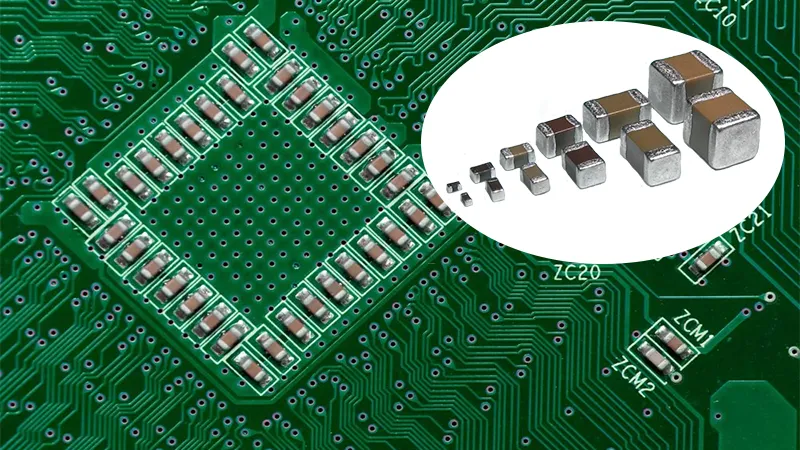
When it comes to selecting capacitors for your electronic circuits, understanding the differences between ceramic and electrolytic capacitors is essential. Both types have their unique characteristics and are suitable for different applications.
Let’s delve into the difference between ceramic and electrolytic capacitor in their use:
1. Ceramic VS Electrolytic Capacitor: Range
- Ceramic Capacitors: These capacitors typically offer lower capacitance values, ranging from a few picofarads to a few microfarads. They are ideal for applications requiring low to moderate capacitance.
- Electrolytic Capacitors: Electrolytic capacitors, on the other hand, provide much higher capacitance values, ranging from several microfarads to thousands of microfarads. They are commonly used in applications requiring higher capacitance, such as power supply filtering and decoupling.
2. Ceramic VS Electrolytic Capacitor: Voltage Rating
- Ceramic Capacitors: Ceramic capacitors usually have lower voltage ratings compared to electrolytic capacitors. They are suitable for low-voltage applications.
- Electrolytic Capacitors: Electrolytic capacitors are available with higher voltage ratings, making them suitable for use in higher voltage circuits, including power supply applications.
3. Ceramic VS Electrolytic Capacitor: Polarization
- Ceramic Capacitors: Ceramic capacitors are non-polarized, meaning they can be connected in any orientation in the circuit. This makes them easy to use and suitable for various applications.
- Electrolytic Capacitors: Electrolytic capacitors are polarized and must be connected in the correct polarity in the circuit. Reversing the polarity can lead to catastrophic failure and damage to the capacitor.
4. Ceramic VS Electrolytic Capacitor: Frequency Response
- Ceramic Capacitors: Ceramic capacitors exhibit excellent high-frequency characteristics due to their low equivalent series resistance (ESR) and low parasitic inductance. They are commonly used in high-frequency applications such as RF circuits and decoupling.
- Electrolytic Capacitors: Electrolytic capacitors may not perform as well at high frequencies due to their higher ESR and parasitic effects. They are typically used in applications where frequency response is not critical.
5. Ceramic VS Electrolytic Capacitor: Size and Form Factor
- Ceramic Capacitors: Ceramic capacitors are available in small surface mount packages, making them suitable for compact designs and high-density PCB layouts.
- Electrolytic Capacitors: Electrolytic capacitors are larger in size compared to ceramic capacitors, especially when higher capacitance values are required. This can be a limiting factor in space-constrained designs.
6. Ceramic VS Electrolytic Capacitor: Temperature Stability
- Ceramic Capacitors: Ceramic capacitors exhibit good temperature stability over a wide temperature range. They can operate reliably in harsh environments.
- Electrolytic Capacitors: Electrolytic capacitors may experience a decrease in capacitance at higher temperatures. Care must be taken to ensure proper derating in elevated temperature applications.
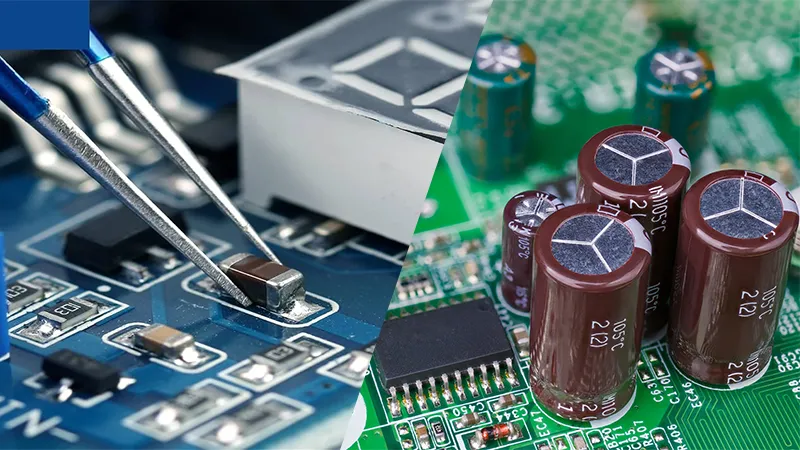
Ceramic VS Electrolytic Capacitors
Ceramic VS Electrolytic Capacitor: Advantage Comparison
Ceramic Capacitors Advantages
High Stability and Reliability: Ceramic capacitors offer exceptional stability and reliability. They maintain consistent performance across various temperatures and voltages. This reliability makes them ideal for critical applications where fluctuations can lead to failure.
Designers trust ceramic capacitors to perform consistently, ensuring long-lasting operation in circuits. When comparing Ceramic VS Electrolytic Capacitor, stability stands out as a significant advantage.
Low Equivalent Series Resistance (ESR): One of the standout features of ceramic capacitors is their low equivalent series resistance (ESR). This characteristic minimizes power loss during operation, allowing for efficient energy transfer. Low ESR is crucial in applications requiring rapid charge and discharge cycles.
Suitable for High-Frequency Applications: Ceramic capacitors excel in high-frequency applications. Their design allows for quick response times, making them perfect for radio frequency and signal processing circuits. Engineers rely on ceramic capacitors to filter out unwanted noise, ensuring clear signal transmission.
Small Size and Low Weight: Ceramic capacitors are compact and lightweight, making them ideal for space-constrained applications. Their small footprint allows designers to create more efficient layouts without sacrificing performance. This advantage proves invaluable in portable electronics, where every millimeter counts.
Electrolytic Capacitors Advantages
High Capacitance Values Available: Electrolytic capacitors shine with their ability to provide high capacitance values. This advantage allows designers to store significant amounts of energy, making them ideal for applications like power supplies and energy storage systems.
Cost-Effective: Electrolytic capacitors offer a cost-effective solution for power supply applications. Their high capacitance combined with relatively low manufacturing costs makes them an attractive choice for budget-conscious projects. Designers can achieve reliable performance without breaking the bank.
Ability To Handle Larger Voltage Ratings: One of the key advantages of electrolytic capacitors is their ability to handle larger voltage ratings. This feature allows them to operate effectively in high-voltage applications without compromising performance. Engineers rely on this capability in power electronics, automotive systems, and renewable energy technologies.
This table focuses on the differences between ceramic and electrolytic capacitors. It outlines their capacitance range, frequency response, applications, polarization, and voltage ratings.
| Aspect | Ceramic Capacitors | Electrolytic Capacitors |
|---|---|---|
| Capacitance Range | Lower capacitance values | Higher capacitance values |
| Frequency Response | Better high-frequency performance due to low ESR | May not perform as well at high frequencies |
| Applications | High-frequency and decoupling applications | Power supply filtering and bulk storage |
| Polarization | Non-polarized | Polarized |
| Voltage Rating | Generally lower voltage ratings | Higher voltage ratings |
Tantalum, Ceramic, Film, and Mica Capacitors
This table compares the key characteristics and applications of tantalum, ceramic, film, and mica capacitors. It highlights their performance, cost, applications, dielectric material, capacitance range, and frequency response.
| Aspect | Tantalum Capacitors | Ceramic Capacitors | Film Capacitors | Mica Capacitors |
|---|---|---|---|---|
| Performance | Lower ESR, Better stability over temperature changes | Generally higher ESR, Moderate stability | Excellent stability, Low ESR | Excellent stability, Low loss |
| Cost | More expensive | Generally more cost-effective | More expensive | More affordable |
| Applications | Stable capacitance applications | High-frequency applications, General-purpose | Audio circuits, Precision timing | High precision and stability applications |
| Dielectric Material | Tantalum | Ceramic | Thin plastic film (Polyester, Polypropylene, Mylar) | Mica |
| Capacitance Range | Wide range, Typically moderate to high | Wide range, Typically low to moderate | Lower capacitance values | Typically lower capacitance values |
| Frequency Response | Limited in high-frequency applications | Excellent high-frequency performance | Suitable for various applications | Suitable for RF and microwave circuits |
Ceramic Capacitor vs Film Capacitor
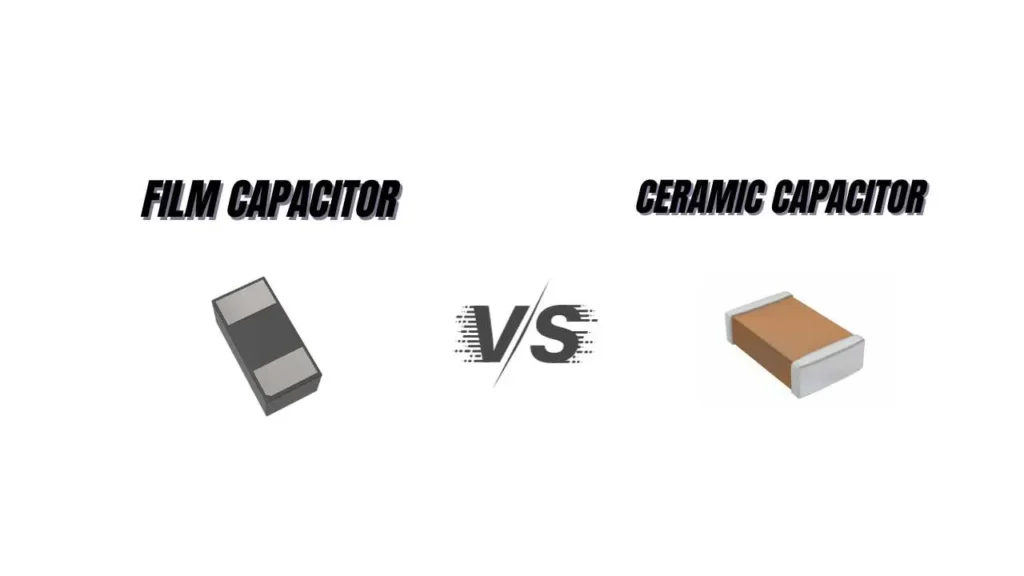
Ceramic and film capacitors are two common types of capacitors used in electronic circuits. While they share the basic function of storing electrical energy, they differ in their construction, performance characteristics, and applications.
Ceramic Capacitors
Dielectric: Ceramic material
Advantages:
- Small size and high capacitance
- Low ESR (Equivalent Series Resistance)
- High reliability and long lifespan
- Wide range of capacitance values
Disadvantages:
- Can be sensitive to temperature and voltage variations
- May exhibit piezoelectric effects, leading to noise and microphonics
Film Capacitors
Dielectric: Plastic film (e.g., polypropylene, polyester, Teflon)
Advantages:
- High stability and low temperature coefficient
- Low dielectric absorption
- High voltage ratings
- Low noise and microphonic noise
Disadvantages:
- Larger size compared to ceramic capacitors
- Lower capacitance values for the same physical size
Comparison Table
| Feature | Ceramic Capacitor | Film Capacitor |
|---|---|---|
| Dielectric | Ceramic | Plastic Film |
| Size | Smaller | Larger |
| ESR | Lower | Higher |
| Temperature Stability | Less Stable | More Stable |
| Voltage Rating | Lower | Higher |
| Cost | Lower | Higher |
| Applications | Decoupling, filtering, timing circuits | Audio, power supplies, RF circuits |
Choosing the Right Capacitor
The choice between ceramic and film capacitors depends on the specific requirements of the application. Consider factors such as:
- Capacitance value: Ceramic capacitors are ideal for smaller capacitance values, while film capacitors are suitable for larger values.
- Voltage rating: Film capacitors are generally more suitable for higher voltage applications.
- Frequency response: Ceramic capacitors often have better high-frequency performance due to their lower ESR.
- Temperature stability: Film capacitors typically exhibit better temperature stability.
- Size and weight: Ceramic capacitors are generally smaller and lighter.
- Cost: Ceramic capacitors are often more cost-effective.
By carefully considering these factors, you can select the appropriate capacitor for your electronic design.
Ceramic vs Mylar Capacitors
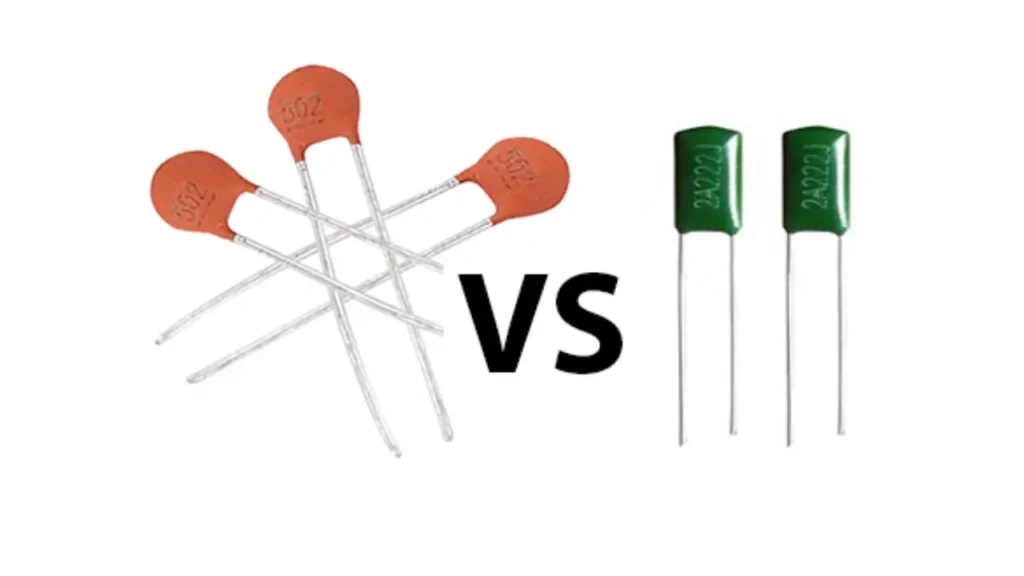
Ceramic and Mylar capacitors are two common types of capacitors used in electronic circuits. While they share the same basic function of storing electrical energy, they differ in their construction, characteristics, and applications.
Ceramic Capacitors
- Construction: Ceramic capacitors are made by coating a ceramic dielectric material with a thin layer of conductive material, typically silver or nickel. They are available in various sizes and shapes, including disc, chip, and multilayer configurations.
- Characteristics:
- High capacitance values in small packages
- Low cost
- Good stability over temperature
- Can exhibit voltage coefficient (capacitance changes with voltage)
- Some types have poor frequency response at higher frequencies
- Applications:
- Decoupling and bypass capacitors in power supplies and digital circuits
- Filtering circuits
- Resonant circuits
- Timing circuits
Mylar Capacitors
- Construction: Mylar capacitors use a thin film of Mylar (polyester) as the dielectric material sandwiched between two metal foils. They are typically wound into a cylindrical shape and encased in a plastic or metal case.
- Characteristics:
- Good stability over temperature and voltage
- Low leakage current
- Good frequency response
- Lower capacitance values compared to ceramic capacitors of similar size
- Higher cost than ceramic capacitors
- Applications:
- Coupling and bypass capacitors in audio and RF circuits
- Timing circuits
- Filtering circuits
- Power supply circuits
Comparison Table
| Feature | Ceramic Capacitors | Mylar Capacitors |
|---|---|---|
| Construction | Ceramic dielectric with conductive coating | Mylar film dielectric with metal foil |
| Capacitance | High values in small packages | Lower values |
| Cost | Low | Higher |
| Stability | Good temperature stability, some voltage coefficient | Good temperature and voltage stability |
| Frequency Response | Can be limited at higher frequencies | Good frequency response |
| Applications | Decoupling, filtering, timing | Coupling, bypass, filtering, timing |
Choosing the Right Capacitor
The choice between ceramic and Mylar capacitors depends on the specific requirements of the application, including:
- Capacitance value: Ceramic capacitors are better suited for higher capacitance values, while Mylar capacitors are more suitable for lower values.
- Voltage rating: Both types are available in a wide range of voltage ratings.
- Temperature stability: Both types offer good temperature stability, but Mylar capacitors may have a slight edge.
- Frequency response: Mylar capacitors generally have better frequency response, especially at higher frequencies.
- Cost: Ceramic capacitors are typically more cost-effective, especially for higher capacitance values.
By carefully considering these factors, you can select the appropriate capacitor for your electronic circuit.
Ceramic vs Tantalum Capacitor
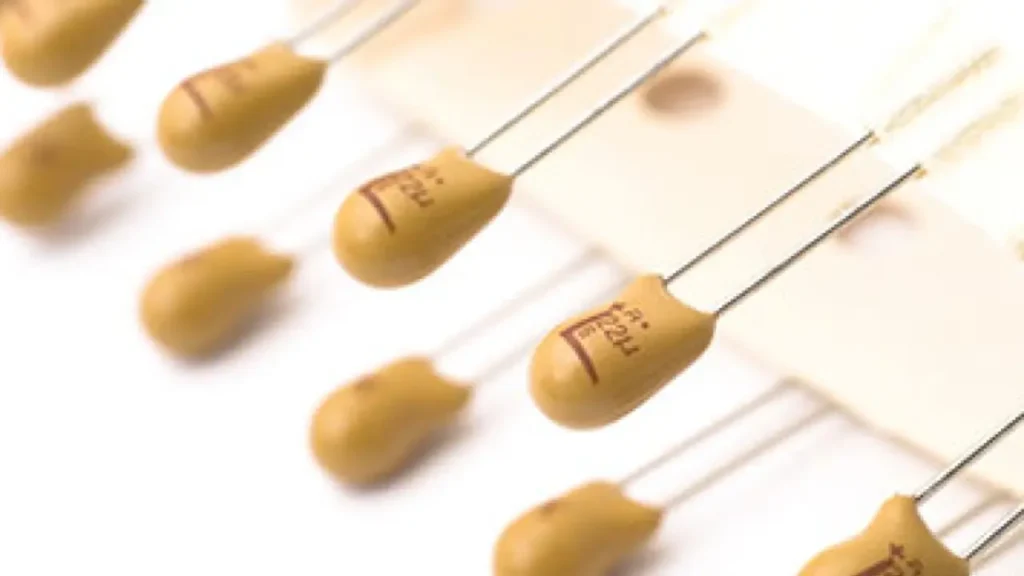
Ceramic and Tantalum capacitors are two common types of capacitors used in electronic circuits. While they share the same basic function of storing electrical energy, they differ in their construction, characteristics, and applications.
Ceramic Capacitors
- Construction: Ceramic capacitors are made by coating a ceramic dielectric material with a thin layer of conductive material, typically silver or nickel. They are available in various sizes and shapes, including disc, chip, and multilayer configurations.
- Characteristics:
- High capacitance values in small packages
- Low cost
- Good stability over temperature
- Can exhibit voltage coefficient (capacitance changes with voltage)
- Some types have poor frequency response at higher frequencies
- Applications:
- Decoupling and bypass capacitors in power supplies and digital circuits
- Filtering circuits
- Resonant circuits
- Timing circuits
Tantalum Capacitors
- Construction: Tantalum capacitors use a thin film of tantalum pentoxide as the dielectric material sandwiched between a tantalum anode and a manganese dioxide cathode. They are typically encased in a metal or plastic case.
- Characteristics:
- High capacitance values in small packages
- Low ESR (Equivalent Series Resistance)
- Good stability over temperature and voltage
- Polarized (must be connected with correct polarity)
- Can be susceptible to voltage spikes and overvoltage
- Applications:
- Decoupling and bypass capacitors in power supplies and digital circuits
- Filtering circuits
- Timing circuits
- Power supply circuits
Comparison Table
| Feature | Ceramic Capacitors | Tantalum Capacitors |
|---|---|---|
| Construction | Ceramic dielectric with conductive coating | Tantalum pentoxide dielectric with tantalum anode and manganese dioxide cathode |
| Capacitance | High values in small packages | High values in small packages |
| Cost | Low | Higher |
| Stability | Good temperature stability, some voltage coefficient | Good temperature and voltage stability |
| Frequency Response | Can be limited at higher frequencies | Good frequency response |
| Polarization | Non-polarized | Polarized |
| Applications | Decoupling, filtering, timing | Decoupling, filtering, timing, power supply |
Choosing the Right Capacitor
The choice between ceramic and tantalum capacitors depends on the specific requirements of the application, including:
- Capacitance value: Both types are capable of achieving high capacitance values in small packages.
- Voltage rating: Both types are available in a wide range of voltage ratings.
- Temperature stability: Both types offer good temperature stability.
- Frequency response: Tantalum capacitors generally have better frequency response, especially at higher frequencies.
- Polarization: Tantalum capacitors are polarized, while ceramic capacitors are non-polarized.
- Cost: Ceramic capacitors are typically more cost-effective.
By carefully considering these factors, you can select the appropriate capacitor for your electronic circuit.
Ceramic vs Polyester Capacitor
Ceramic and polyester capacitors are two common types of capacitors used in electronic circuits. While they share the same basic function of storing electrical energy, they differ in their construction, characteristics, and applications.
Ceramic Capacitors
- Construction: Ceramic capacitors use a ceramic dielectric material coated with a conductive material, typically silver or nickel. They are available in various sizes and shapes, including disc, chip, and multilayer configurations.
- Characteristics:
- High capacitance values in small packages
- Low cost
- Good stability over temperature
- Can exhibit voltage coefficient (capacitance changes with voltage)
- Some types have poor frequency response at higher frequencies
- Applications:
- Decoupling and bypass capacitors in power supplies and digital circuits
- Filtering circuits
- Resonant circuits
- Timing circuits
Polyester Capacitors
- Construction: Polyester capacitors use a thin film of polyester as the dielectric material sandwiched between two metal foils. They are typically wound into a cylindrical shape and encased in a plastic or metal case.
- Characteristics:
- Good stability over temperature and voltage
- Low leakage current
- Good frequency response
- Lower capacitance values compared to ceramic capacitors of similar size
- Higher cost than ceramic capacitors
- Applications:
- Coupling and bypass capacitors in audio and RF circuits
- Timing circuits
- Filtering circuits
- Power supply circuits
| Feature | Ceramic Capacitors | Polyester Capacitors |
|---|---|---|
| Construction | Ceramic dielectric with conductive coating | Polyester film dielectric with metal foil |
| Capacitance | High values in small packages | Lower values |
| Cost | Low | Higher |
| Stability | Good temperature stability, some voltage coefficient | Good temperature and voltage stability |
| Frequency Response | Can be limited at higher frequencies | Good frequency response |
| Applications | Decoupling, filtering, timing | Coupling, bypass, filtering, timing |
Choosing the Right Capacitor
The choice between ceramic and polyester capacitors depends on the specific requirements of the application, including:
- Capacitance value: Ceramic capacitors are better suited for higher capacitance values, while polyester capacitors are more suitable for lower values.
- Voltage rating: Both types are available in a wide range of voltage ratings.
- Temperature stability: Both types offer good temperature stability.
- Frequency response: Polyester capacitors generally have better frequency response, especially at higher frequencies.
- Cost: Ceramic capacitors are typically more cost-effective, especially for higher capacitance values.
By carefully considering these factors, you can select the appropriate capacitor for your electronic circuit.
Ceramic Capacitor ESR vs Frequency
The ESR (Equivalent Series Resistance) of a ceramic capacitor can vary with frequency. Generally, ceramic capacitors exhibit low ESR, especially at higher frequencies. However, as the frequency increases, the parasitic inductance of the capacitor’s leads and internal structure can become more significant, leading to a slight increase in ESR.
Key Factors Influencing ESR vs. Frequency:
- Capacitor Type: Different types of ceramic capacitors (Class 1, Class 2) have different ESR characteristics.
- Capacitance Value: Larger capacitance values tend to have higher ESR.
- Package Size: Smaller package sizes often have lower ESR.
- Operating Temperature: Temperature can affect the ESR of a capacitor.
Why is ESR Important?
- Power Dissipation: Higher ESR leads to increased power dissipation, which can cause the capacitor to heat up and potentially fail.
- Signal Integrity: ESR can impact the signal integrity of high-speed circuits, leading to distortion and noise.
- Circuit Performance: In high-frequency applications, a capacitor with low ESR is crucial for optimal performance.
Selecting the Right Ceramic Capacitor:
When selecting a ceramic capacitor for a specific application, it’s essential to consider the ESR and frequency requirements. By carefully considering these factors, you can ensure that the capacitor will perform as expected and contribute to the overall reliability and efficiency of your electronic circuit.
Note: To get precise information about the ESR vs. frequency characteristics of a specific ceramic capacitor, refer to the manufacturer‘s datasheet.
Ceramic Capacitor Impedance vs Frequency
Understanding the Relationship
The impedance of a ceramic capacitor, like any capacitor, decreases as the frequency increases. This is due to the capacitive reactance, which is inversely proportional to frequency.
However, real-world capacitors, including ceramic capacitors, have parasitic components that can influence their impedance behavior at higher frequencies:
- Equivalent Series Resistance (ESR): This represents the resistive component within the capacitor, which can cause power dissipation and limit the capacitor’s performance at high frequencies.
- Equivalent Series Inductance (ESL): This represents the inductive component, primarily due to the leads and internal structure of the capacitor. At higher frequencies, the inductive reactance can dominate, causing the impedance to increase.
Ideal vs. Real-World Behavior:
- Ideal Capacitor: The impedance would decrease continuously with increasing frequency, following the ideal capacitive reactance formula: Z = 1/(jωC).
- Real-World Capacitor: Due to ESR and ESL, the impedance curve deviates from the ideal behavior. At lower frequencies, capacitive reactance dominates. As the frequency increases, the inductive reactance becomes more significant, leading to a peak in impedance at the self-resonant frequency (SRF). Beyond the SRF, the capacitor’s behavior becomes more inductive.
Key Considerations:
- Choose the right capacitor for the application: Consider the operating frequency range and the required impedance characteristics.
- Minimize parasitic effects: Select capacitors with low ESR and ESL, especially for high-frequency applications.
- Use appropriate mounting techniques: Proper mounting can help reduce parasitic inductance.
- Refer to the manufacturer‘s datasheet: The datasheet provides detailed information about the capacitor’s impedance characteristics, including ESR and SRF.
By understanding the impedance behavior of ceramic capacitors, you can make informed decisions when designing electronic circuits and ensure optimal performance.
Can I Use a Ceramic Capacitor Instead of Electrolytic?
Can I replace the electrolytic capacitor with a ceramic?
You can often use a ceramic capacitor instead of an electrolytic capacitor, but it depends heavily on the specific application and the required electrical characteristics.
When Ceramic Capacitors Can Replace Electrolytic Capacitors:
- Smaller Capacitance Values: Ceramic capacitors are generally more suitable for lower capacitance values. If your application requires only a few microfarads or less, a ceramic capacitor can often be a direct replacement.
- High-Frequency Applications: Ceramic capacitors exhibit much lower ESR (Equivalent Series Resistance) than electrolytic capacitors, making them superior for high-frequency applications.
- Applications Requiring Low Leakage Current: Ceramic capacitors typically have much lower leakage currents than electrolytic capacitors.
- Applications Requiring High Stability: Ceramic capacitors generally exhibit better stability over temperature and voltage variations compared to electrolytic capacitors.
When Electrolytic Capacitors Are Preferred:
- Large Capacitance Values: Electrolytic capacitors are the preferred choice for applications requiring large capacitance values (microfarads to millifarads).
- Applications Requiring High Ripple Current: Electrolytic capacitors are generally better at handling high ripple currents, which are common in power supply circuits.
- Cost-Sensitive Applications: For large capacitance values, electrolytic capacitors are often more cost-effective than ceramic capacitors.
Important Considerations:
- Polarity: Electrolytic capacitors are polarized, meaning they have a defined positive and negative terminal. Ceramic capacitors are generally non-polarized.
- Voltage Rating: Ensure the voltage rating of the ceramic capacitor is sufficient for the application.
- Physical Size: Consider the physical size and mounting requirements of both capacitor types.
While ceramic capacitors offer several advantages, they may not always be a suitable replacement for electrolytic capacitors. Carefully evaluate the specific requirements of your application, such as capacitance value, voltage rating, ripple current, and frequency, before making a decision.
Conclusion
In conclusion, understanding the differences between Ceramic and electrolytic Capacitor is essential for making informed choices in your electronic projects. Ceramic capacitors excel in stability and high-frequency applications, while electrolytic capacitors provide higher capacitance and are suitable for power supply circuits.
Knowing when to use each type can significantly enhance your designs. For reliable components, quote ceramic capacitors from us today!